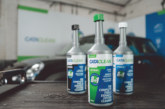Neil Pattemore looks at the impact of the ‘connected vehicle’ on the parts distribution sector.
If you are reading this article, it is almost certainly because you are in the Aftermarket replacement parts sector, but this sector is now coming under an increasing threat that is not directly part of your business activity.
Most of your business is likely to come from workshops who need parts to service and repair their customers’ vehicles. This process could be described as the ‘repair order process’ and starts with the vehicle coming to the workshop for routine service and maintenance, or is created when a fault develops and through diagnostics, the replacement part required is identified. However, a new challenge is coming from a direction which may not even be ‘on your radar’.
“The fundamental basis of the Aftermarket having un-monitored access to in-vehicle data, free of charge and with the ability to offer customers a competitive choice, is under serious threat…”
What is changing?
You will be familiar with the old adage of ‘familiarity breeds contempt’, but you may not be familiar with how this may soon impact your business, as the ‘connected car’ becomes the everyday reality. You may never have stopped to think about it, but in one way or another, the standardised 16 pin connector has become the basis of your customers’ business – and subsequently your business! So what is this threat and what is changing?
Quite simply, with new technologies supporting remote access to the vehicle, any faults or forthcoming (predictive) service and maintenance information is now available to the vehicle manufacturers who are increasingly entering the Aftermarket.
However, we have all heard about the new remote access (telematics) systems (driven by the mandatory introduction of the ‘eCall’ system in all newly type approved vehicles from 2018) and the various threats of both remotely ‘hacking’ the vehicle, or being able to connect to the in-vehicle networks through the 16 pin connector to re-program keys and steal the vehicle. Subsequently, in-vehicle security is being significantly enhanced and the ability to communicate through the 16 pin connector for normal diagnostics, or for repair and maintenance is now being restricted to when the vehicle is stationary in the workshop – i.e. no data available remotely when driving.
So remote access to in-vehicle data is only available to the vehicle manufacturers – allowing them to propose service or repair offers directly to the customer, directing them to a workshop proposed by the vehicle manufacturer and which is likely to use the vehicle manufacturer’s spare parts as part of their offer.
The challenge is how the vehicle manufacturers will continue to comply with the legislative requirements of providing access to vehicle data for independent operators. Vehicle manufacturers have therefore proposed their ‘extended vehicle’ concept as the only solution. This provides access to the vehicle data via the ‘back-end’ of the vehicle manufacturer’s server.
New threats
This will introduce several new threats to your business. Firstly, the vehicle manufacturer controls all access to the vehicle and its data and subsequently the data available may become more limited and will be defined by ‘use cases’, meaning that the data will be defined as ‘engine’, or ‘brakes’, so if you need to work on ‘steering’, it will be another use case – and each use case may be restricted to pre-verified certificates/diagnostic tools and may also be separately chargeable! There may also be other increases in costs, as diagnostic tool manufacturers will no longer be able to create their diagnostic programs using reverse engineering, but will have to buy expensive diagnostic data from the vehicle manufacturers and then spend more money to re-engineer it to become part of their multi-brand tool.
Secondly, the vehicle manufacturer is in constant communication with the vehicle, so is able to monitor the status of the vehicle, together with when a part may fail (prognostics) or a service is due (predictive maintenance).
Thirdly, and probably most significantly, the vehicle manufacturer can directly contact the driver and propose their repair or service offer – diverting the driver to their preferred workshop – meaning that many of your customers may never see the vehicle and be able repair it, with the associated parts that you would have supplied, or would now be using vehicle manufacturer’s spare parts. The vehicle manufacturers are now not only entering the diagnostic, service and repair market, but are in a dominant position to control it.
Even if the driver brings their vehicle to your customer’s workshop, if the repair workshop then accesses vehicle data via the vehicle manufacturer’s ‘extended vehicle server’, then the vehicle manufacturer will know who they are, what vehicle they are working on and what parts may be required. From this they can offer their own parts in competition to your offer, which may also be made ‘more attractive’ with reduced costs of access to technical information, or other vehicle manufacturer related services.
The fundamental basis of the Aftermarket having un-monitored access to in-vehicle data, free of charge and with the ability to offer customers a competitive choice, is under serious threat, both from the ability to access vehicle data for the Aftermarket to offer new ‘remote services’ and to maintain independent repair methods. Direct access to in-vehicle data both remotely and via the 16 pin connector are critical to the future of the independent Aftermarket.
Obviously, this threat is being strongly opposed by the UK Aftermarket trade associations, working through their European offices in Brussels to maintain legislative support, but never has access to vehicle data through the humble 16 pin connector become such an important part of the Aftermarket’s future.








